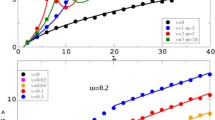Abstract
The localization properties of three different gauge invariant disordered electronic systems are studied by numerical methods with the purpose to clarify their localization properties and to evaluate the dc-resistivity atT=0 K as far as possible. The three different models, two of which involve also spin-dependent scattering processes, represent three different universality classes, corresponding to orthogonal, unitary, and symplectic matrix ensembles, respectively, in a field-theoretic representation. For the symplectic case, which corresponds to a situation with dominating spin-orbit scattering, we find hints for an unconventional transition, separating weakly antilocalized from exponentially localized states, whereas in the other two cases instead of a sharp transition only a drastic crossover between weak localization and exponential localization seems to happen. For the symplectic model also the magnetoresistivity is calculated; we find a negative magnetoresistivity if the Zeeman splitting is neglected, whereas by inclusion of Zeeman splitting the magnetoresistivity is positive.
Similar content being viewed by others
References
Stein, J., Krey, U.: Z. Phys. B — Condensed Matter34, 287 (1981)
Stein, J., Krey, U.: Z. Phys. B — Condensed Matter37, 13 (1980)
Stein, J., Krey, U.: Physica106A, 326 (1981)
Stein, J., Krey, U.: Solid State Commun.36, 951 (1980)
Abrahams, E., Anderson, P.W., Licciardello, D.C., Ramakrishnan, T.V.: Phys. Rev. Lett.42, 673 (1979)
Anderson, P.W., Abrahams, E., Ramakrishnan, T.V.: Phys. Rev. Lett.44, 1153 (1980)
See e.g. Pepper, M.: In: Lecture Notes in Physics. Vol. 149, p. 177. Berlin, Heidelberg, New York: Springer Verlag 1981
Licciardello, D.C., Thouless, D.J.: Phys. Rev. Lett.35, 1475 (1975)
Wegner, F.: In: Lecture Notes in Physics. Vol. 149, p. 191. Berlin, Heidelberg, New York: Springer Verlag 1981
Hikami, S., Larkin, A., Nagaoka, Y.: Prog. Theor. Phys.63, 707 (1980); As stressed in this paper, for strictly two-dimensional systems, in contrast to thin films of a width which is much larger than the Fermi wavelength, the symplectic case cannot be realized, since it is necessary that the orbital motion can have a component, which is in the normal direction
Oppermann, R., Jüngling, K.: J. Phys. C14, 3745 (1981)
Jüngling, K., Oppermann, R.: Z. Phys. B — Condensed Matter38, 93 (1980)
Oppermann, R.: J. Phys. C14, 3757 (1981)
One should note that the conductivity of a finite sample will depend erratically on the choice of this sample unless the measurements are either performed at a finite frequency ω or at a finite temperature, leading to a finite, inelastic lifetime τ1 of the eigenstates. To avoid this erratic dependence, ħω or ħ/τ1 should be much larger as the minimal spacing δE=(N d g(E))−1 of two eigenstates at the Fermi energy
Hikami, S.: Prog. Theor. Phys.64, 1466 (1980)
Gorkov, L.P., Larkin, A.I., Khmelnitzkii, D.E.: JETP Lett.30, 229 (1979)
Bergmann, G.: Private communication
m>l means for the conventional arrangement of the square lattice that eitherm x>l x, or instead,m y>l y
Lee, P.A., Fisher, D.S.: Phys. Rev. Lett.47, 882 (1982)
Maekawa, S., Fukuyama, H.: J. Phys. Soc. Jpn.50, 2516 (1981)
Economou, E.N., Cohen, M.H.: Phys. Rev. B5, 2931 (1972)
One should note that the density of state vanishes only beyond the Lifshitz edgesE L;E L=4W 2 in casea, =8W 2 in casesb andc
Altshuler, B.L., Aharonov, A.G., Lee, P.A.: Phys. Rev. Lett.44, 1288 (1980)
Lee, P.A., Ramakrishnan, T.V.: Preprint
Uren, M.J., Davies, R.A., Kaveh, M., Pepper, M.: J. Phys. C14, 5737 (1981)
Pichard, J.L., Sarma, G.: Jpn. Phys. C14, L127 (1981)
MacKinnon, A., Kramer, B.: Phys. Rev. Lett.47, 1546 (1981)
Author information
Authors and Affiliations
Rights and permissions
About this article
Cite this article
Krey, U., Maaß, W. & Stein, J. Numerical studies on the Anderson localization problem. Z. Physik B - Condensed Matter 49, 199–208 (1982). https://doi.org/10.1007/BF01313027
Received:
Issue Date:
DOI: https://doi.org/10.1007/BF01313027




